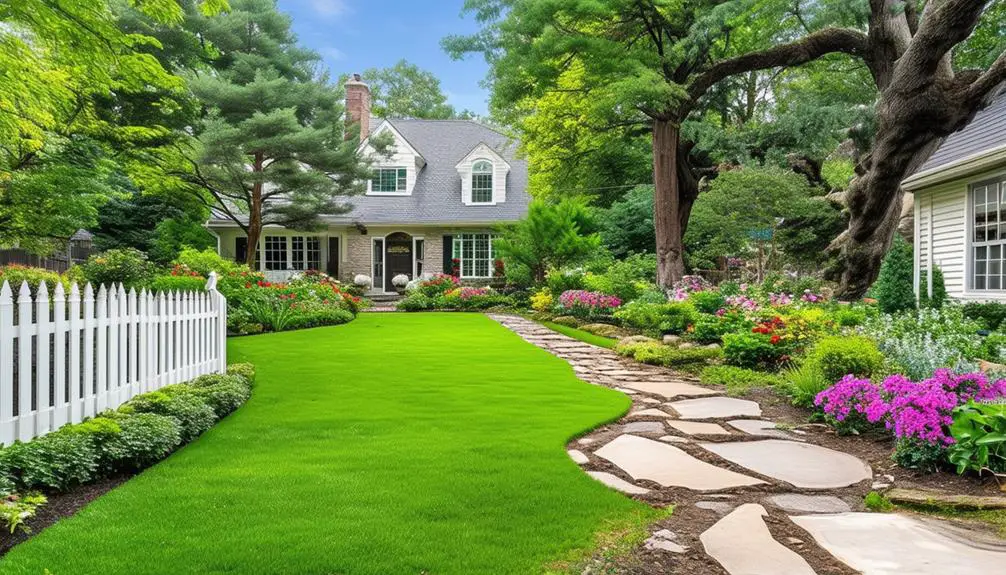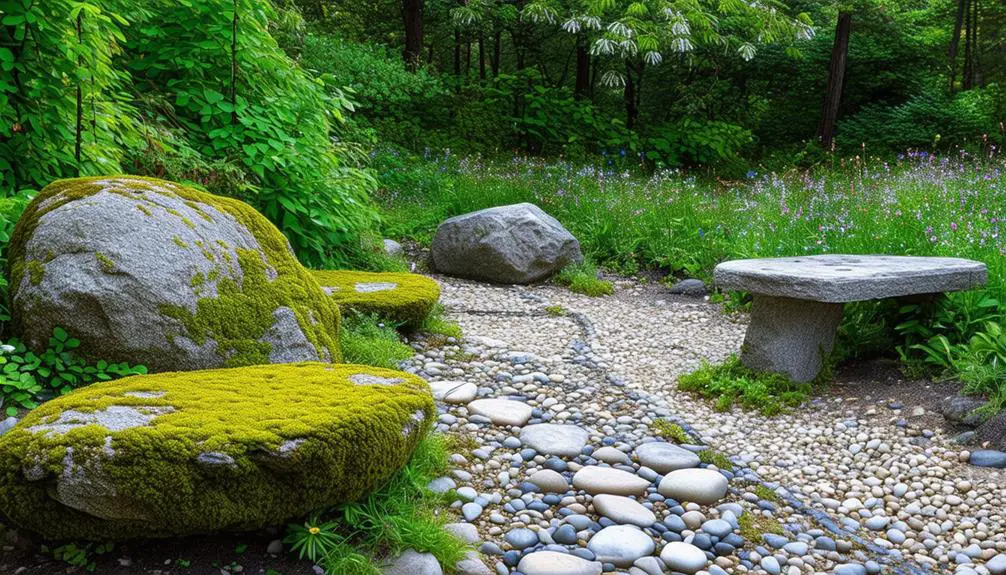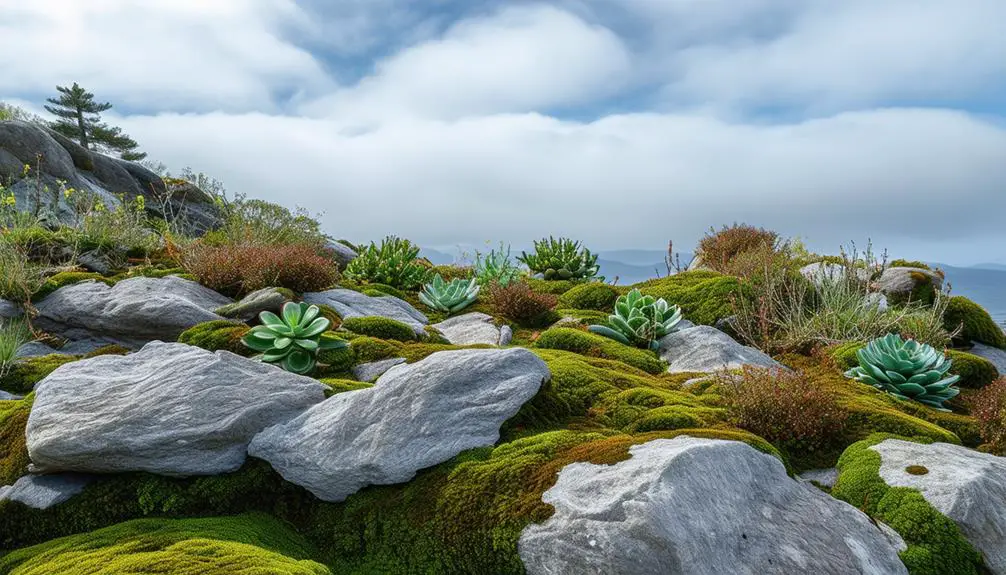When creating a rock garden, you'll want to choose plants that can thrive in harsh conditions and poor soil. You're probably wondering which ones will perform well in your unique setting. From spreading ground covers like creeping thyme to vibrant, drought-tolerant flowers like yarrow, there are many options to ponder. But which ones will truly shine in your rock garden? Let's explore the best plants for your space, and discover how to create a beautiful, low-maintenance oasis that will impress friends and family alike.
Creeping Thyme for Ground Cover

When designing a rock garden, you'll want to ponder a low-maintenance, spreading ground cover to fill in gaps between stones and pavers, and creeping thyme (Thymus serpyllum) is an ideal choice.
This perennial herb forms a dense, flat mat of tiny, gray-green thyme leaves that can tolerate light foot traffic.
Creeping thyme thrives in well-draining soil and full sun to partial shade, making it perfect for rock gardens.
As you walk on the thyme, you'll release its pungent, minty thyme fragrance, adding an olfactory dimension to your outdoor space.
To maintain creeping thyme, simply trim it back after flowering to encourage new growth and prevent it from becoming leggy.
You can also divide and replant it in the spring or fall to keep it healthy and vigorous.
With its spreading habit and low-growing profile, creeping thyme is an excellent ground cover for rock gardens, requiring minimal care while providing maximum visual interest.
Sedum Varieties for Rock Gardens
You'll find sedum varieties that serve as excellent ground covers, such as Sedum spurium and Sedum anglicum, which spread quickly and thrive in poor soil.
If drought tolerance is your top priority, consider Sedum album or Sedum rupestre, both of which can survive with minimal watering.
With sedum, you'll also have a range of color options, from the blue-gray foliage of Sedum dasyphyllum to the vibrant yellow flowers of Sedum adolphi.
Sedum Ground Cover Options
Sedum ground cover options offer a diverse range of varieties, each with unique characteristics that make them well-suited for rock gardens.
You can choose from low-growing, spreading sedums that form a dense mat, or upright sedums that provide a more structural element to your landscape. When selecting a sedum ground cover, consider factors such as growth rate, texture, and color to guarantee the best fit for your rock garden.
Sedum propagation is relatively easy, allowing you to quickly fill in gaps and create a lush, cohesive look.
Simply divide established plants, or take cuttings from the tips of stems. You can also use sedum landscaping techniques such as layering, where you place stems on top of soil and secure them with rocks, to create a natural, sprawling effect.
Some popular sedum ground cover options include Sedum spurium, which forms a dense, red-tinged mat, and Sedum anglicum, which has delicate, blue-gray foliage.
Sedum hispanicum, with its tiny, white blooms, is another attractive option. By choosing the right sedum ground cover for your rock garden, you can create a beautiful, low-maintenance landscape that thrives in challenging conditions.
Drought Tolerant Sedum Types
Rock gardens often face water scarcity, making drought-tolerant sedum types a vital component of a thriving landscape.
When selecting sedum varieties for your rock garden, you'll want to focus on those that can survive with minimal watering. Sedum anglicum, also known as English stonecrop, is an excellent choice, as it can tolerate extreme drought and requires minimal Sedum propagation.
Sedum spurium, or Caucasian stonecrop, is another popular option that can thrive in dry conditions, making it an ideal choice for water-conscious gardeners.
To guarantee the health and longevity of your sedum, regular Sedum pruning is essential.
This involves removing dead or damaged leaves and stems, which helps promote healthy growth and prevents the spread of disease.
You can also use Sedum pruning as an opportunity to propagate new plants, as sedum cuttings can easily be rooted in well-draining soil.
Sedum Color Variations
Beyond their remarkable drought tolerance, sedum varieties for rock gardens also offer a diverse palette of colors to enhance the aesthetic appeal of your landscape.
You can choose from a range of sedum colors, including soft pastels, vibrant hues, and rich jewel tones. For a subtle look, opt for sedum varieties like 'Moonstone' or 'Lime Zinger', which feature delicate shades of pale yellow and green.
If you want to add a pop of color, consider 'Dragon's Blood' or 'Firecracker', which boast deep red and orange hues.
Sedum's rich history dates back to ancient Greece, where it was used in medicinal remedies.
Today, sedum symbolism is often associated with love, protection, and good fortune. When selecting sedum varieties for your rock garden, consider the symbolism behind each color.
For example, red sedum is often linked with passion and energy, while white sedum is associated with purity and innocence.
Alpine Succulents for High Altitude

Elevation's harsh conditions demand plants with specific adaptations to thrive.
When creating a rock garden at high altitude, you'll need plants that can withstand intense sunlight, strong winds, and limited water availability.
Alpine succulents are a great choice, as they've evolved to survive in these conditions. Look for species like Sempervivum, Sedum, and Rosularia, which are commonly found in Alpine nurseries.
These plants have adapted to high elevation by developing thick, waxy leaves that store water, reducing transpiration and conserving energy. They also often have a low-growing, spreading habit, allowing them to anchor themselves in rocky crevices and withstand strong winds.
When selecting alpine succulents, choose varieties with compact growth habits and vibrant colors to add visual interest to your rock garden.
Be sure to plant them in well-draining soil and provide full sun to partial shade, depending on the species' requirements.
With proper care, these hardy plants will thrive in your high-altitude rock garden, providing a stunning display of color and texture.
Ornamental Grasses for Texture
You'll find that ornamental grasses bring a unique dimension to your rock garden with their softly swaying foliage, which creates a soothing visual effect.
In addition, many species display dramatic plume displays, adding a striking vertical element to your design.
Softly Swaying Foliage
Among the varied textures that can add depth and visual interest to your rock garden, softly swaying foliage from ornamental grasses stands out for its unique ability to create movement and flow.
You'll find that the whispering leaves and wispy stems of these grasses provide a dynamic visual experience, as they respond to even the lightest breeze.
To incorporate this texture into your design, consider using grasses with delicate, feathery plumes, such as Stipa tenuissima or Nassella tenuissima.
These species will add a soft, romantic quality to your rock garden, while their slender stems will create a sense of airiness and lightness.
When selecting ornamental grasses for your rock garden, look for varieties with fine, hair-like foliage, as these will provide the most dramatic movement and flow.
Dramatic Plume Displays
Incorporating dramatic plume displays into your rock garden design can elevate the visual appeal of your softly swaying foliage.
Ornamental grasses, such as pampas grass and fountain grass, produce stunning plumes that add texture and movement to your garden. These grasses have feathery plumes that sway gently in the breeze, creating a dramatic display of color and texture.
For a more subtle effect, ponder using grasses with silky plumes, such as blue oat grass or golden hakonechloa. These plumes have a soft, delicate texture that adds a sophisticated touch to your garden.
When choosing ornamental grasses for your rock garden, ponder the mature size of the plant, as well as its growth habits. Some grasses can grow quite tall, while others are more compact.
You'll also want to ponder the color and texture of the plumes, as well as the foliage of the grass. By combining different types of ornamental grasses, you can create a dynamic and interesting display of texture and color in your rock garden.
Year-Round Interest
Several ornamental grasses provide year-round interest to your rock garden by offering varied textures that add depth and visual appeal even in the dormant season.
These grasses undergo seasonal metamorphoses, changing color and form to create a dynamic display throughout the year. In winter, some ornamental grasses produce winter blooms, adding a touch of elegance to your rock garden even in the coldest months.
For example, Pennisetum setaceum 'Rubrum' produces vibrant purple-red foliage that remains attractive even in winter, while Stipa arundinacea displays golden plumes that shimmer in the winter sun.
When selecting ornamental grasses for your rock garden, consider their texture, color, and growth habits.
Combine fine-textured grasses like Festuca glauca with coarser ones like Cortaderia selloana to create visual interest.
Also, choose grasses that complement the colors and textures of your rocks and other plants.
Drought-Tolerant Yarrow for Sun
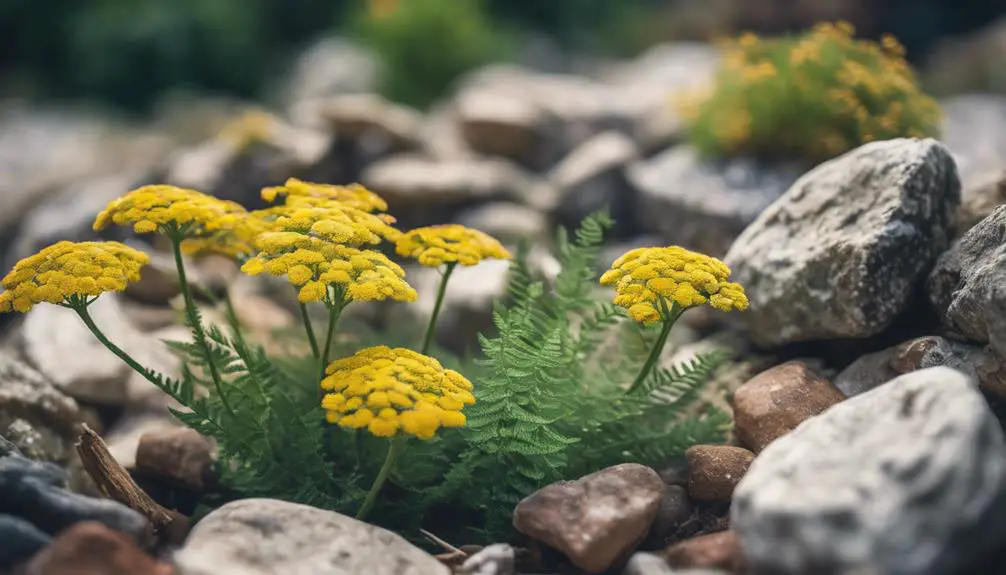
Growing a thriving rock garden in full sun often requires careful plant selection, and drought-tolerant yarrow is an excellent choice for such conditions.
This perennial flower boasts numerous benefits, including its ability to tolerate extreme heat, dryness, and poor soil quality.
Yarrow's fern-like foliage and white or yellow blooms add texture and color to your rock garden, while its spreading habit helps to suppress weeds.
You'll appreciate the low maintenance requirements of yarrow, which only needs occasional watering and pruning to prevent overcrowding.
Simply cut back the stems after blooming to encourage new growth and prevent self-seeding.
Yarrow maintenance is relatively effortless, making it an ideal choice for busy gardeners.
Additionally, yarrow attracts beneficial insects, such as bees and butterflies, and its leaves can be used in herbal remedies.
With its versatility and hardiness, yarrow is an excellent addition to any rock garden, providing year-round interest and beauty.
Low-Growing Phlox for Color
With its vibrant flowers and low-maintenance requirements, low-growing phlox is an excellent addition to your rock garden, providing a burst of color in full sun.
As a low-growing plant, phlox won't overwhelm your rock garden, making it an ideal choice for small spaces. You'll be rewarded with fragrant, pink, purple, or white blooms that attract pollinators and add visual interest to your garden.
When it comes to phlox care tips, make sure to plant them in well-draining soil and full sun to partial shade.
Water them regularly, but avoid overwatering, which can lead to root rot. Divide and replant every 3-4 years to maintain their vigor.
Consider pairing phlox with companion plants like creeping thyme, sedum, or stonecrop, which share similar growing conditions and provide a cohesive look.
Creeping Juniper for Slopes
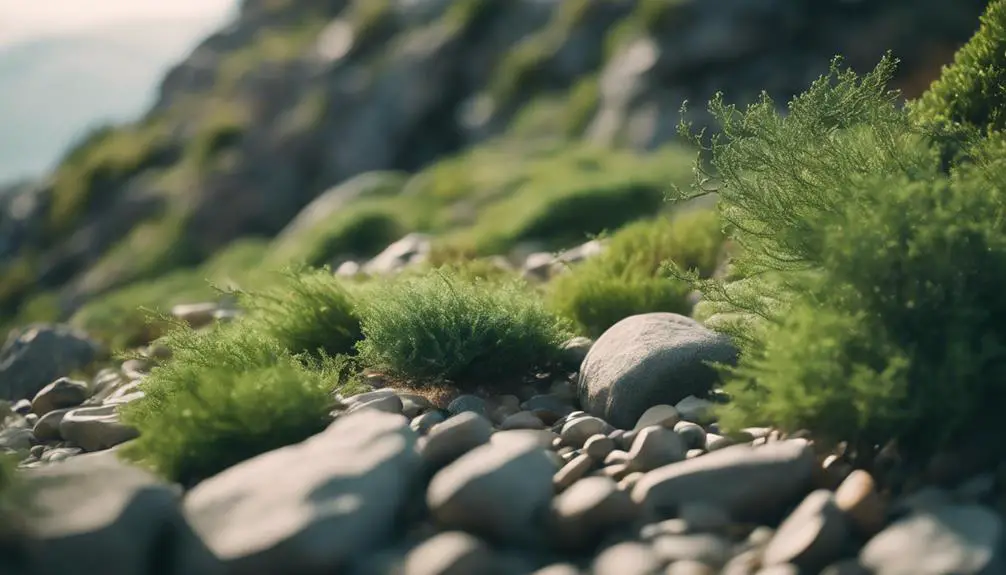
When selecting creeping juniper for your rock garden slopes, you'll want to ponder the soil tolerance levels of different species, as some can thrive in poor soil with minimal watering while others require more moisture.
You'll also need to implement spreading control methods to keep the juniper from overtaking other plants, such as containing it with physical barriers or regular pruning.
Soil Tolerance Levels
Creeping juniper's adaptability to varying soil tolerance levels makes it an ideal choice for rock gardens, particularly on slopes where soil quality can be compromised.
You'll find that this plant thrives in acidic soils with a pH as low as 5.5, making it a great option for areas with high concentrations of peat or organic matter. However, it's not limited to acidic environments; creeping juniper also exhibits alkaline adaptability, tolerating pH levels up to 8.0.
This flexibility allows you to plant it in a variety of locations without worrying about soil pH constraints.
When planting on slopes, you'll appreciate creeping juniper's ability to stabilize the soil and prevent erosion.
Its extensive root system helps to bind the soil together, creating a stable foundation for the plant to grow. As you design your rock garden, keep in mind that creeping juniper can tolerate a range of soil textures, from sandy to clay-based soils.
Spreading Control Methods
As you incorporate creeping juniper into your rock garden design, consider its natural tendency to spread, which can be beneficial for stabilizing slopes but may also lead to unwanted encroachment on surrounding plants.
To control the spread, you can employ mulch barriers, which involve applying a 2-3 inch layer of organic mulch around the perimeter of the juniper. This physical barrier will prevent the roots from spreading beyond the desired area.
For more effective control, consider using physical barriers such as landscape edging or plastic root barriers. These can be installed 12-18 inches deep around the perimeter of the juniper, preventing the roots from growing beyond the designated area.
Regular pruning is also essential to maintain the desired shape and size of the juniper. By combining these methods, you can enjoy the benefits of creeping juniper in your rock garden while preventing unwanted spread.
Dwarf Conifers for Year-Round Interest
Two to three dwarf conifers can provide a striking focal point in your rock garden, offering year-round interest with their varied textures, colors, and shapes.
You can choose from a range of species, such as Chamaecyparis, Abies, and Pinus, each with its unique characteristics. To maintain their compact growth habit, regular dwarf conifer pruning is essential.
Prune them in the spring, removing any dead or damaged branches, and shaping the plant to maintain its desired form.
When selecting conifer companion plants, ponder those that complement their textures and colors.
Low-growing sedums, creeping thyme, and dwarf phlox can fill in gaps between the conifers, creating a cohesive look.
You can also incorporate ornamental grasses, like blue oat grass or pennisetum, to add movement and contrast.
By combining dwarf conifers with complementary plants, you can create a visually appealing rock garden that changes with the seasons.
Remember to weigh factors like soil type, sunlight, and moisture levels when selecting plants, ensuring a thriving and dynamic garden.
Rockrose for Coastal Rock Gardens
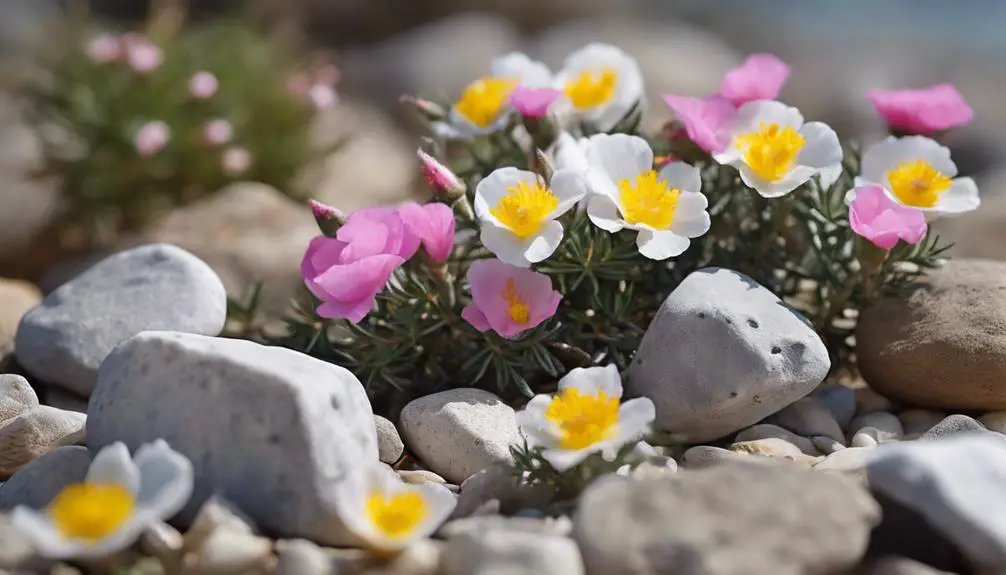
Rockrose, a low-maintenance, drought-tolerant shrub, is an ideal choice for coastal rock gardens where salt-laden winds and dry conditions prevail.
You'll appreciate its ability to thrive in harsh environments, making it a perfect fit for areas where other plants would struggle to survive. With its coastal hardiness, Rockrose can tolerate the high salt levels and strong winds that come with living near the ocean.
As you're selecting plants for your coastal rock garden, consider Rockrose's fragrant blooms, which will add a pleasant aroma to your outdoor space.
The blooms, which appear in shades of pink, yellow, and white, will attract pollinators and add a pop of color to your garden. Rockrose is also a low-growing shrub, reaching heights of around 3-6 feet, making it an excellent choice for smaller rock gardens or those with limited space.
When planting Rockrose, be sure to choose a location with full sun to partial shade and well-draining soil. With proper care, Rockrose will provide you with a beautiful, low-maintenance addition to your coastal rock garden.
Delosperma for Vibrant Colors
During the peak summer months, when coastal rock gardens can start to look parched and worn, Delosperma steps in to bring a burst of vibrant color to the scene.
As a succulent, Delosperma is well-suited for rock gardens, thriving in full sun and dry to moderate soil moisture. You'll appreciate its low-maintenance requirements, as it can survive with infrequent watering and doesn't need fertilization.
When choosing Delosperma varieties, look for ones with compact growth habits, such as 'Kelaidis' or 'Alan's Apricot', which won't overtake neighboring plants.
Delosperma care tips include deadheading spent flowers to encourage more blooms and dividing established plants every 3-4 years to maintain their vigor.
In respect to Delosperma winter hardiness, most species can tolerate temperatures as low as -20°F (-29°C), making them an excellent choice for coastal rock gardens in USDA zones 5-9.
Blue Fescue for Accent Plants
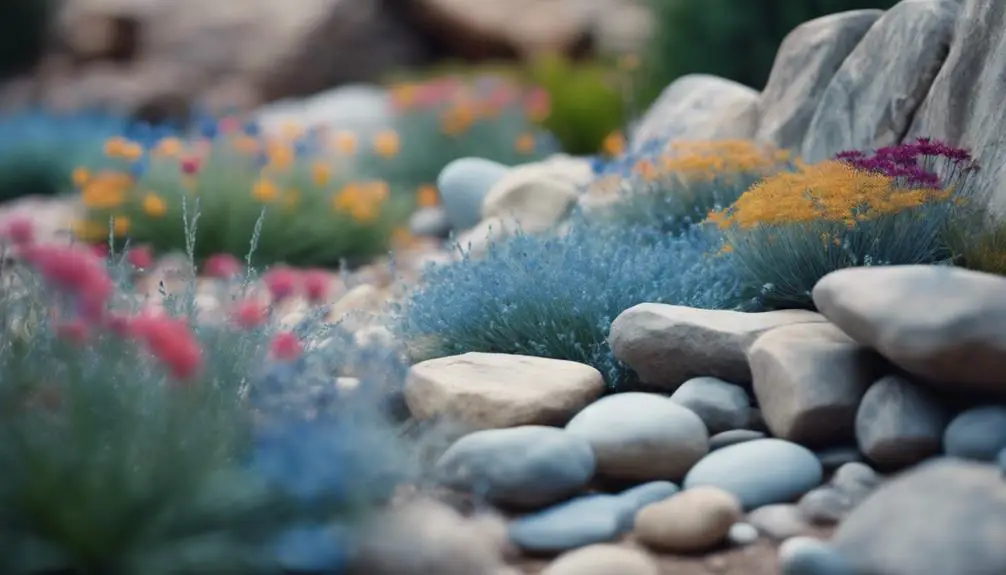
Creating a visually appealing rock garden often relies on incorporating accent plants that add contrasting textures and hues to the landscape.
Blue Fescue, a low-maintenance, clumping grass, is an excellent choice for adding a silvery-blue accent to your rock garden. With its delicate, thread-like foliage, it provides a striking contrast to coarser-textured plants.
You'll appreciate the history behind Blue Fescue, as it's a cultivar of the species Festuca glauca, native to Europe and Asia. Its natural habitat is in dry, rocky areas, making it an ideal choice for rock gardens.
When it comes to Fescue maintenance, you'll find it's relatively easy-going. Blue Fescue prefers well-draining soil and full sun to partial shade. Water it sparingly, as it's drought-tolerant, and divide it every 2-3 years to maintain its compact shape.
Sempervivum for Unique Shapes
You'll discover Sempervivum, a genus of succulents, offers a fascinating array of unique shapes to add visual interest to your rock garden.
Their rosettes, ranging from tight and compact to loose and sprawling, provide an intriguing contrast to the rigid lines of rocks and gravel. Some species, like Sempervivum arachnoideum, feature fuzzy rosettes that resemble tiny, delicate stars, while others, such as Sempervivum calcareum, have smooth, rounded leaves that shimmer in the sunlight.
What's more, Sempervivum are incredibly hardy, with many species boasting excellent winter hardiness, making them an excellent choice for rock gardens in zones with harsh winters.
With proper care, Sempervivum can thrive in poor soil and withstand extreme temperatures, making them a low-maintenance addition to your outdoor space.
Frequently Asked Questions
How Often Should I Water Plants in a Rock Garden?
When determining your water schedule, you'll want to check soil moisture daily, especially during hot spells, and water only when the top inch of soil feels dry to the touch, avoiding overwatering.
Can I Use Regular Potting Soil in a Rock Garden?
You shouldn't use regular potting soil in a rock garden, as it can retain too much water, causing root rot; instead, opt for a mix with good soil structure and a neutral soil pH, allowing for ideal drainage and healthy plant growth.
Do Rock Gardens Require a Lot of Maintenance?
You'll find that maintaining a rock garden requires moderate effort, as you'll need to guarantee soil preparation aligns with your rock garden goals, controlling weeds and erosion while preserving soil structure and nutrient balance.
Can I Create a Rock Garden in a Shady Area?
You can create a thriving rock garden in a shady area by selecting Shady species that tolerate low light conditions, and positioning plants to maximize Dappled light, which filters through trees, ensuring a stunning, low-maintenance landscape.
How Do I Prevent Weeds From Growing in a Rock Garden?
To prevent weeds from growing in your rock garden, you'll install a weed barrier fabric beneath the rocks, then apply mulch layers to block sunlight and prevent seed germination, ensuring a pristine, weed-free space.
Conclusion
You've selected a range of resilient plants, each suited to thrive in harsh rock garden conditions. Creeping thyme and sedum will carpet the area with minimal upkeep, while alpine succulents like sempervivum add unique shapes. Ornamental grasses provide texture, and drought-tolerant yarrow and delosperma bring vibrancy. Rockrose and blue fescue offer striking accents. With these low-maintenance plants, your rock garden will flourish, requiring only occasional watering and pruning to maintain its beauty and resilience.


